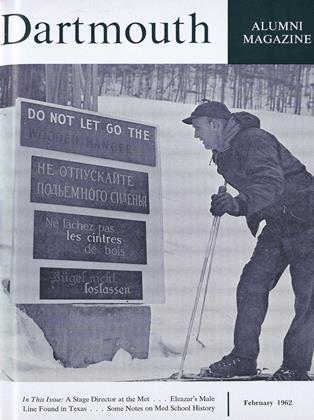By Myron Tribus. Princeton,N. J.: Van Nostrand, 1961. 649 pp.$10.95.
This textbook, written by the new Dean of the Thayer School of Engineering, presents a re-development of a fundamental engineering study concerned with the protean capabilities of different forms of energy. It may be regarded as an avant garde book in thermodynamics: it breaks sharply with the traditional rationale and has stirred up vigorous discussions in engineering and science circles about its novel approach and its importance.
Conventional engineering thermodynamics is usually studied as it has evolved historically. Gases or vapors which serve as energy carriers in engineering systems have been conceptualized as continuums in order to obtain information about energy transformations. It was realized by the founding fathers of thermodynamics about a century ago that such information might be obtained from the realistic perception of a mass, of gas as a myriad of molecules at different energy levels. But their intellectual means for discerning order and meaning from the apparent chaos of trillions of molecules moving at random were vague and inadequate. With the discovery of the quantum theory in 1900, which suggests that the energy of molecules is absorbed or emitted in steps or quanta, and the information theory formulated in 1948, which permits the evaluation of the gross properties of a conglomeration of molecules without complete information about each molecule, the tools were at hand to deal with gases and vapors from the molecular viewpoint. These have been used in this unique book.
According to Dean Tribus the rationale he has applied to the development of thermodynamics in this book was in part inspired by the inadequacy of conventional thermodynamics to explain such novel methods of energy conversion as occur in thermo-electric and thermionic power systems. He has developed wider applications of the ideas developed in his book to such studies as reliability engineering, communication theory, decision making, and game theory.
 View Full Issue
View Full Issue
More From This Issue
-
 Feature
FeatureThe Very Old and the Old
February 1962 By DR. FREDERIC P. LORD '98 -
 Feature
FeatureStage Director at the Met
February 1962 By RAYMOND J. BUCK '52 -
 Feature
FeatureKenneth Allan Robinson
February 1962 By F. CUDWORTH FLINT -
 Feature
FeatureELEAZAR WHEELOCKS, IN DIRECT LINE, STILL LIVE – IN TEXAS
February 1962 By SEYMOUR E. WHEELOCK '40 -
 Class Notes
Class Notes1950
February 1962 By SCOTT C. OLIN, SIMON J. MORAND III -
 Class Notes
Class Notes1931
February 1962 By WILLARD C. WOLFF, JOHN K. BENSON, JAMES B. GODFREY
JOSEPH J. ERMENC
Books
-
 Books
BooksInfection with the Organism of Vincent
November, 1922 -
 Books
BooksSet of Freud Presented
JUNE 1967 -
 Books
BooksALUMNI PUBLICATIONS
April 1921 By K.A.R. -
 Books
BooksTHE EUROPEAN ANCESTRY OF VILLON'S SATIRICAL TESTAMENTS
February 1942 By Leon Verriest -
 Books
BooksELEMENTARY STATISTICS FOR ECONOMICS AND BUSINESS: SELECTED READINGS.
NOVEMBER 1970 By RICHARD STUART BOWER -
 Books
BooksUp From the Nickelodeon
NOVEMBER 1981 By Robert H. Ross '38


